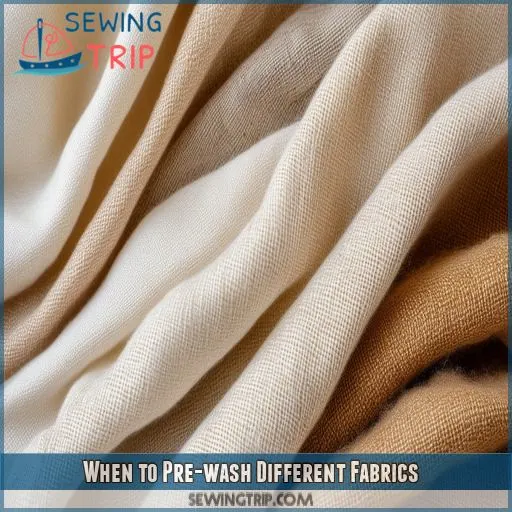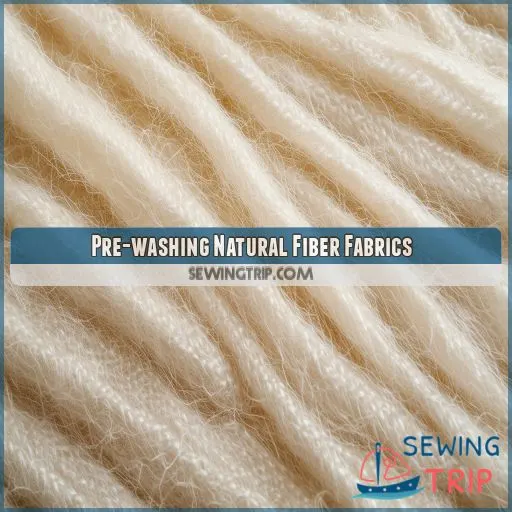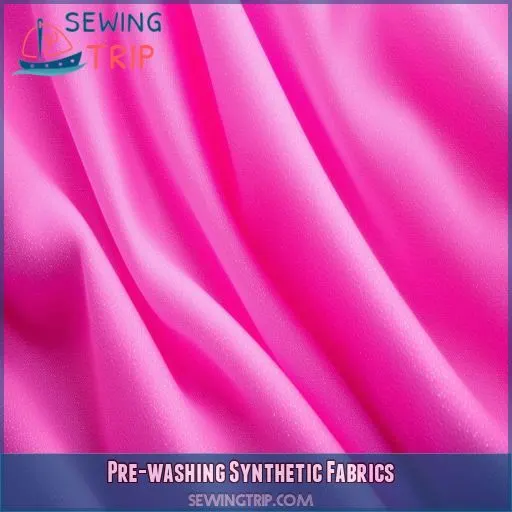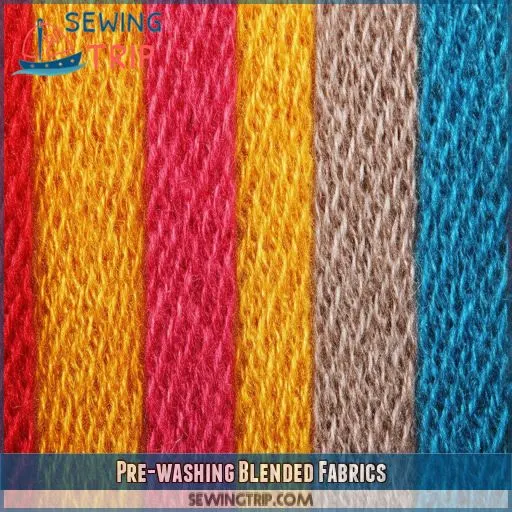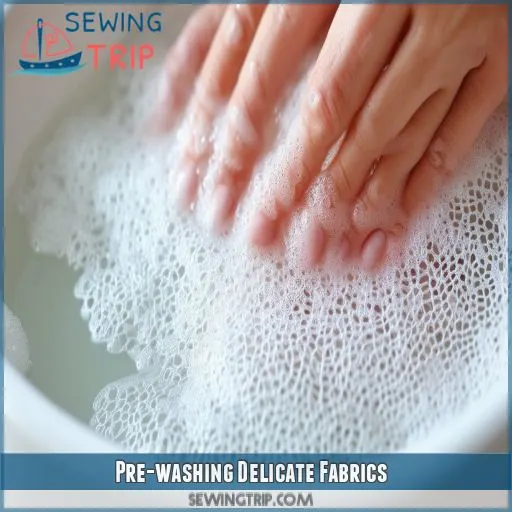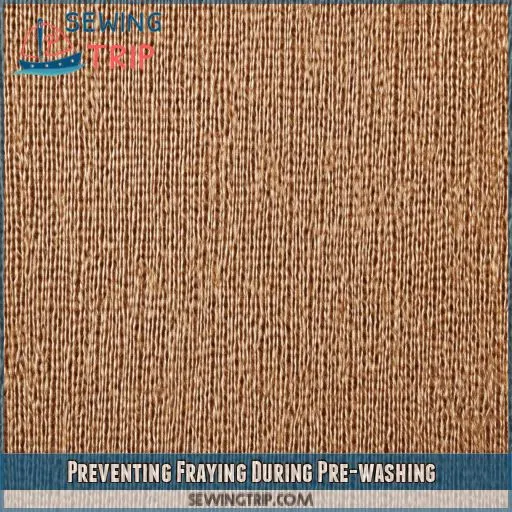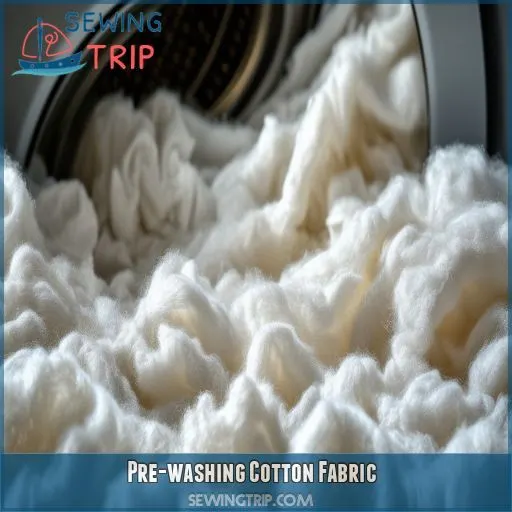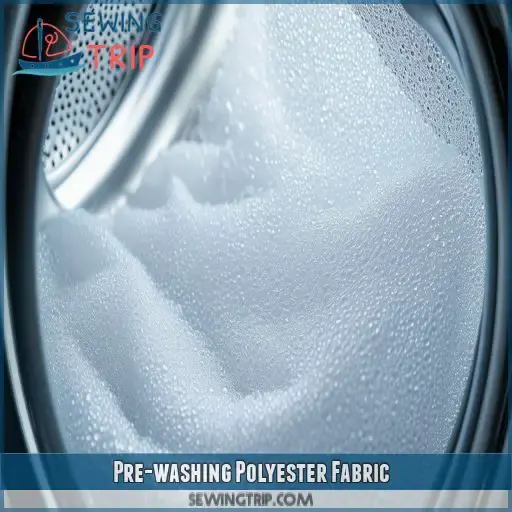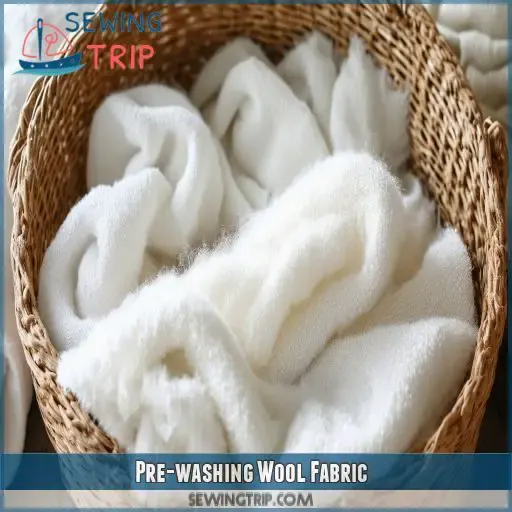This site is supported by our readers. We may earn a commission, at no cost to you, if you purchase through links.
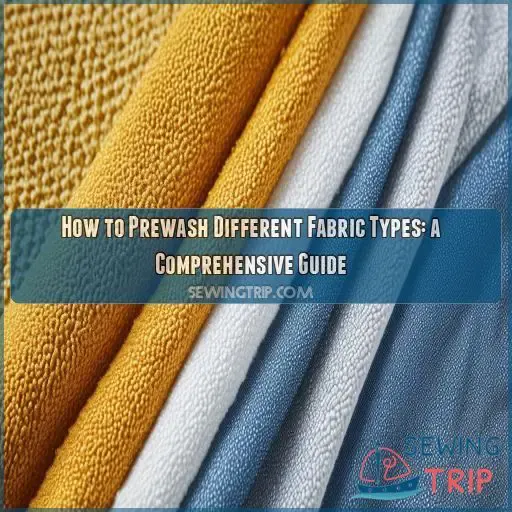
Today, we’re focusing on a crucial step often overlooked: prewashing fabric.
This step is vital as it ensures your creations withstand the test of time and the washing machine.
Whether you’re a quilting expert or an aspiring fashion designer, prewashing fabric is essential to avoid disasters like shrinkage and color bleeding.
In this comprehensive guide, we will take you on a journey through the ins and outs of prewashing various fabric types, including Natural fibers and synthetics.
Table Of Contents
- Key Takeaways
- How to Prewash Different Fabric Types?
- When to Pre-wash Different Fabrics
- Pre-washing Natural Fiber Fabrics
- Pre-washing Synthetic Fabrics
- Pre-washing Blended Fabrics
- Pre-washing Delicate Fabrics
- Preventing Fraying During Pre-washing
- Pre-washing Cotton Fabric
- Pre-washing Polyester Fabric
- Pre-washing Silk Fabric
- Pre-washing Wool Fabric
- Frequently Asked Questions (FAQs)
- Conclusion
Key Takeaways
- Prewashing is a secret weapon to avoid wardrobe malfunctions like shrinkage and color disasters.
- Natural fibers like cotton and silk need some TLC before you stitch, so give ’em a prewash to keep their shape.
- Synthetic fabrics are usually pre-shrunk and colorfast; skip the prewash unless you want to get rid of that "new fabric smell."
- Delicate fabrics like silk and lace need a gentle touch, so hand-wash them carefully to preserve their best look.
How to Prewash Different Fabric Types?
Understanding how to pre-wash different fabric types is a vital skill for preserving the condition of your garments and extending their lifespan.
When preparing to pre-wash, it’s essential to take into account the type of fabric. Natural fibers such as cotton, linen, silk, and wool benefit from being pre-washed, while synthetic fabrics like polyester and nylon can generally be spared this step.
For natural fiber fabrics, use lukewarm water and a gentle detergent, then allow to air dry. For synthetic fabrics, choose lukewarm or cool water and a small amount of mild detergent, then either air dry or use a low heat setting.
Delicate fabrics require special attention, which we will address in greater detail, along with other fabric-specific recommendations, in the subsequent sections.
When to Pre-wash Different Fabrics
When discussing pre-washing fabrics, timing is paramount. While the urge to commence a new sewing project is understandable, allocating time to pre-wash your fabric can mitigate future inconveniences. So, when is the ideal time to pre-wash?
The answer is contingent on the fabric type and its intended purpose. Natural fibers like cotton, linen, silk, and wool are ideal candidates for pre-washing. These fabrics have a propensity to shrink, so pre-washing guarantees that your project won’t end up smaller than intended. It’s also prudent to pre-wash fabrics that will be laundered after construction, particularly if they contain excess dye or chemical sizing. This prevents colors from bleeding and undesirable chemicals from persisting on your completed garment.
Conversely, certain fabrics don’t necessitate pre-washing. Synthetic fabrics, such as polyester and nylon, are frequently pre-shrunk and colorfast, allowing you to skip this additional step. The same applies to fabrics that won’t be washed, such as pouches, and those with permanent starch treatments.
Pre-washing Natural Fiber Fabrics
Now that you know when to pre-wash, let’s explore the specifics of pre-washing natural fiber fabrics. This includes fabrics like cotton, linen, silk, and wool, which are commonly used in clothing and home decor. Here’s a step-by-step guide to mastering the art of pre-washing these delicate materials:
- Lukewarm Water: Always use lukewarm water when pre-washing natural fibers. Hot water can cause shrinkage and damage the delicate fibers.
- Mild Detergent: Opt for a mild, gentle detergent to avoid any harsh chemicals that may affect the fabric’s color or texture. Use a small amount, as too much detergent can leave residue.
- Air Dry: After washing, gently remove the fabric from the water and avoid wringing or twisting. Instead, lay it flat or hang it up to air dry. This prevents stretching and helps maintain the fabric’s shape.
Keep these tips in mind when pre-washing natural fiber fabrics like linen, rayon, hemp, bamboo, and Tencel. Each fabric has its unique characteristics, but these basic steps will guarantee your natural fibers are pre-washed effectively, setting you up for sewing success!
Pre-washing Synthetic Fabrics
Synthetic fabrics, such as polyester and nylon, are known for their durability and resistance to shrinkage and fraying. While pre-washing isn’t necessary for these fabrics, you may still choose to do so for certain items, especially those that will be washed after construction, like athletic wear or swimwear.
When pre-washing synthetic fabrics, it’s important to use the right techniques to avoid any potential damage. Here’s a table with some key tips:
| Tip | Description |
|---|---|
| Water Temperature | Use lukewarm or cool water to prevent any potential damage to the fabric. |
| Detergent | Choose a mild detergent and use a small amount to avoid residue. |
| Drying | Air dry or use a low-heat setting in the dryer to prevent shrinkage and maintain fabric integrity. |
Pre-washing Blended Fabrics
Blended fabrics, such as cotton-polyester, cotton-rayon, and cotton-linen blends, require special attention during pre-washing. The key is to balance the care instructions for the different fibers. For instance, cotton tends to shrink, so a cotton-polyester blend may necessitate a delicate cycle with lukewarm water to prevent excessive shrinkage.
When pre-washing silk-polyester blends, it’s essential to avoid using fabric softeners and dryers, as these can harm the delicate silk fibers. Instead, choose air-drying and use a mild detergent.
Wool-polyester blends should be washed separately or with similar colors to prevent potential dye transfer. It’s also important not to overload the washing machine, as this can result in inadequate rinsing and residue accumulation.
Pre-washing Delicate Fabrics
Delicate fabrics such as lace, velvet, satin, silk organza, and chiffon require special care when prewashing.
These fabrics are often made with synthetic fibers, so it is important to handle them gently.
To prewash delicate fabrics:
- Use a mesh laundry bag to protect the fabric.
- Employ lukewarm water and a mild detergent, avoiding fabric softeners.
- Submerge the fabric for 45-60 minutes, then gently squeeze to remove air bubbles.
- Air dry the fabric until it is half dry, and then use a low-heat iron to complete the drying process.
Always read the care label and wash similar colors together to prevent any mishaps.
Preventing Fraying During Pre-washing
Preventing fraying during pre-washing is essential for keeping your fabric in top shape. Here are some tips to help you:
- Baste the raw edges of your fabric to temporarily secure them and prevent fraying.
- Use a mesh laundry bag in the washing machine to provide an extra layer of protection and prevent tangling.
- Avoid overfilling the machine, as this can cause excess friction and lead to fraying.
- Opt for a gentle spin cycle to reduce the risk of fraying and speed up drying time.
- Steer clear of the dryer; the heat and tumbling can cause fraying and set-in creases.
Pre-washing Cotton Fabric
Now that you know how to prevent fraying during pre-washing, let’s proceed to the specifics of pre-washing cotton fabric. Cotton is a natural fiber and, therefore, requires special attention before it’s sewn into your desired garment or item. Here’s what you need to know:
- Cotton Fabric Shrinkage: Cotton has a tendency to shrink, so it’s important to pre-wash it to guarantee your final product fits as intended.
- Dye Removal: Cotton fabrics may also bleed dye, so pre-washing helps to remove any excess dye and prevent discoloration during future washes.
- Starch Removal: Cotton fabrics often have starch treatments, which need to be eliminated before use. Pre-washing removes these treatments, ensuring your fabric is soft and ready for sewing.
- Life Extension: By taking the time to pre-wash your cotton fabric, you’re also investing in the longevity of your future garment. This simple step helps extend the life of the fabric, making your creation last longer.
- Use lukewarm water and a mild detergent.
- Wash by itself or with similar colors to avoid any potential dye transfer.
- Don’t overfill your washing machine, as this can impact the effectiveness of the wash and lead to uneven results.
- Air dry or use a low-heat setting on your dryer.
- If needed, finish drying with an iron on a gentle setting.
Pre-washing Polyester Fabric
Pre-washing polyester fabric is generally unnecessary due to its synthetic nature, which makes it resistant to shrinkage and dye bleeding. However, if you’re working with polyester that has a strong odor or noticeable static, a quick pre-wash can help.
Use lukewarm water and a mild detergent, avoiding fabric softeners, and remove the fabric promptly from the washer. Dry on a low heat, gentle cycle, and shake the fabric flat to remove wrinkles. Finish by ironing while slightly damp for a smooth finish.
Pre-washing Silk Fabric
Silk is a delicate fabric that requires special care when pre-washing. Here’s a step-by-step guide to doing it right:
- Hand-washing silk is best. Fill a basin with lukewarm water and add mild detergent. Submerge and gently agitate. Soak for 5–10 minutes, then rinse with cool water.
- Dry cleaning is an option. Specify it’s silk to guarantee the right solvents and methods.
- Iron silk on the lowest setting with a pressing cloth. Iron while slightly damp.
- Store silk in a cool, dry place, avoiding sunlight. Consider a breathable cotton bag.
- Mothproofing silk is a must. Use cedar blocks, lavender sachets, or commercial mothballs/crystals.
Pre-washing Wool Fabric
Wool is a natural fiber that benefits from pre-washing, especially if you plan to wash the final garment. Here’s a guide to pre-washing wool fabric:
First, identify the type of wool fabric you’re working with. Wool fabric types vary, and some may have specific care instructions. Check the fabric label for any special care instructions or warnings.
Next, pre-washing wool fabric can help remove excess dye and prevent shrinkage. Use lukewarm water and a mild detergent. Avoid fabric softeners, as they may affect the wool’s natural properties. Submerge the fabric and gently agitate it for a few minutes. You can also use a gentle cycle on your washing machine, ensuring it’s not overloaded.
After washing, remove the fabric from the water and gently squeeze out the excess. Avoid wringing or twisting, as this can damage the fibers. Instead, roll the fabric in a towel to absorb moisture and then lay it flat to dry.
Frequently Asked Questions (FAQs)
How do you wash different types of fabric?
Regarding fabric care, it’s a complex realm. One must comprehend how to manage each fabric’s unique traits. Here’s a swift guide: invert denim and launder on a gentle, delicate cycle. Hand wash viscose and wool with cool water and a mild detergent. Satin and chiffon are demanding and require hand-washing with delicate detergent and no twisting.
What fabrics should I pre wash?
Pre-wash natural fibres like cotton, linen, wool, silk, and denim. Synthetic fabrics should also be pre-washed to check for colour bleeding.
Can you wash different fabrics together?
You can wash similar colours together, but separate lights and darks. Avoid washing lint-producing and lint-attracting fabrics together. Mixing denser fabrics with lighter ones can wear out the lighter clothing, so wash jeans separately.
Do I need to pre-wash polyester fabric?
No, you don’t need to pre-wash polyester fabric. In fact, it’s unnecessary to pre-wash synthetic fabrics.
Is pre-washing always necessary?
Pre-washing is unnecessary for synthetic fabrics like polyester and nylon, items not intended for washing, pre-shrunk and colorfast dyed fabrics, and fabrics with permanent starch treatments. If your clothes are only slightly dirty, a regular or quick wash cycle will suffice.
Does pre-washing impact the fabrics appearance?
Yes, pre-washing can impact the appearance of your fabric. It can cause colours to fade, especially if they’re bright or dark. Poor-quality fabrics are more likely to fade. Pre-washing also removes chemicals and dirt, giving the fabric a cleaner look.
What happens if I skip pre-washing?
If you skip pre-washing, you risk unexpected shrinkage, fraying, and bleeding of colours. You might also find your fabric is harder to work with, and the final product may not fit as intended.
How do I dry delicate fabrics?
Hang delicates to air dry. Avoid dryers, which can damage the fabric. Lay knitwear flat to dry. For very fragile clothes, lay them on a clean towel to maintain their shape.
How can I prevent colours from bleeding?
To prevent colours from bleeding, use a colour fixative, wash similar colours together, and wash by hand in cool water. Wash white items separately the first time to rinse out any loose dye.
Conclusion
Now you’re prepared to overcome any prewashing obstacles.
You’ve explored the nuances of prewashing various fabric types: from natural fibers to synthetics, and even examined the specifics of cotton, polyester, silk, and wool.
With this knowledge, you can guarantee your sewing creations are both impressive and enduring.

